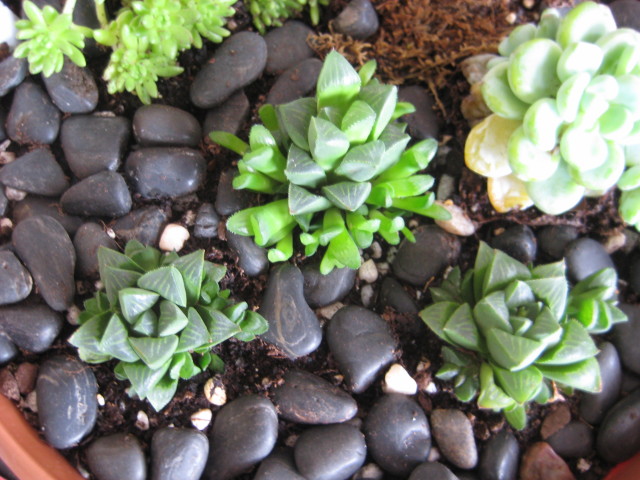Question
 H. mutica x 3
H. mutica x 3
Hello Will, I have heard great things about you.
I love succulents, have a passion for Haworthias and a special spot in my heart for H. mutica var. mutica. I bought a the 3 you see in my picture from Home Depot about 3 months ago. The one in the middle was the first one I bought and is obviously doing very well. The other two are doing well, but have not "exploded" like the middle one apparently has.
I would very much like your advice for keeping these plants happy and healthy. I understand that haworthias require more regular watering and less sunlight when compared to other succulents. They like to grow between rocks and grow very slowly. They flower occasionally as well.
I would like to know if I should take babies from the middle exploding plant to make new plants. If this is a good idea, what is a good process for me to accomplish this for the best results? The internet has given me so much conflicting information, and I would like to know if these were your plants, how you would do it?
Next, am I doing an okay job with the soil? The pot is 6 inches deep and the bottom is filled with pebbles. I used organic soil and mixed in a great many pebbles, and then put a layer of pumice on top. Please let me know if this is ideal, or how you would do it differently. I plan to remove the sedums and make the pot an entirely mutica pot!
Thanks!!!!
AnswerHi Clare,
Specialty plant species, such as Orchids and Haworthias, generate a lot of different theories on cultural practices. Hobbyists have many different approaches for the care of their pet species. What many do not understand is that what works for them, may not work for someone else. Hence, you get lots of conflicting advice. Ultimately, you will have to try some things that you think may work for you. With some experimentation, you will discover what does work for you and you can then ignore everyone else's contrary advice, perhaps including mine!
H. mutica is a 'windowed' Haworthia. It grows in hot, dry climates in southern Africa. The summer heat can desiccate theses plants quickly, so they have evolved to have short, squatty leaves that are very close to the ground and out of the sun. They also grow in shaded areas out of the sun. Part of their adaptation is their translucent leaf tips (windows) that allow light to penetrate into the interior of the plant where photosynthesis can take place without exposing the plant to the intense heat of the sun.
Your Haworthia can therefore survive in lower light than many other Haworthia species. However, outdoor shade can be more intense than indoor direct sun, so it is best to keep yours on a sunny windowsill when indoors.
Because Haworthias grow in places with thin, rocky, sandy soil, it is best to pot them in a very gritty potting mix, which you seem to understand. There are dozens of different potting mix recipes that will accomplish the goal of allowing moisture to penetrate the roots, but that also dry out quickly. The more gritty or porous the mix, the more frequently it will need to be watered. Adding a thin layer of small pebbles or pumice on top does more to enhance the natural appearance of teh Haworthia than to improve its growing environment.
I suggest a shallow pot or bulb pan made of unglazed terra cotta with no stones or pebbles underneath. Shallow pots help display theses low plants better and also help prevent root rot.
But think twice before you repot. Repotting is like surgery - it is somewhat traumatic and there are inherent risks. Never repot for the sake of repotting. Do it only if you have a compelling reason to do it. And then do it carefully so you disturb the roots as little as possible. Never wash away old soil from the roots as that will damage the very tiny root-hairs.
Your Haworthia is self-propagating, meaning it spreads on its own via its offsets or baby plants. Personally, I think it is best to leave them alone and allow them to slowly spread across the pot. However, the offsets can be removed carefully with a few roots attached and replanted elsewhere if you are feeling adventurous. There is nothing you can do to make them produce more offsets other than trying to provide good light and watering appropriately. I would not fertilize more than once per year and then only at half strength.
Please let me know if any of this is unclear or if you have any additional questions.
If this information has been helpful, please click the Rate Volunteer bar below and enter a rating and nomination for me. I am a volunteer on this site so Ratings are the only compensation I receive for answering plant questions.
Need more information? Visit my website at www.HorticulturalHelp.com
or email me at
[email protected] or call me at 917-887-8601 (EST)
Regards,
Will Creed, Interior Landscaper
Horticultural Help, NYC
Visit my website at www.HorticulturalHelp.com






